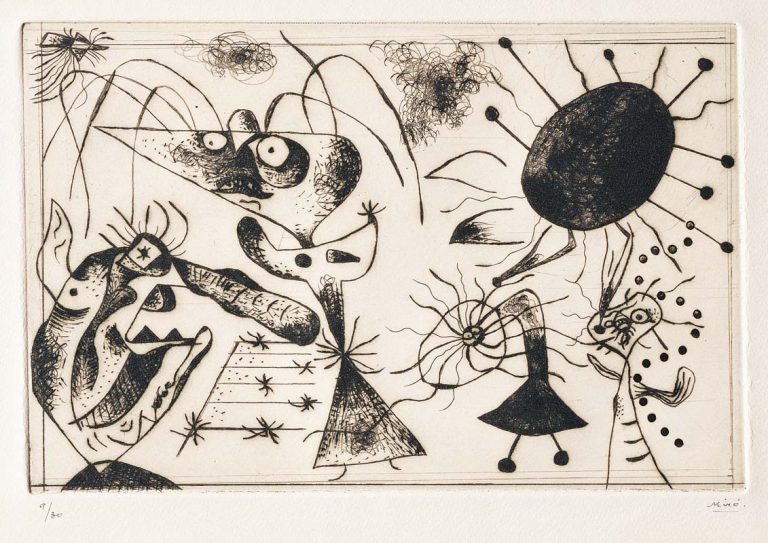We acknowledge the Traditional Owners of the land on which the Queensland Art Gallery | Gallery of Modern Art stands and recognise the creative contribution First Australians make to the art and culture of this country.

Joan Miró / Spain 1893–1983 / (Untitled) (from ‘Noire et rouge’ series) 1938 / Drypoint on Arches paper / 17 x 25.7cm / Purchased 1996. Queensland Art Gallery Foundation Grant / Collection: Queensland Art Gallery | Gallery of Modern Art / © Successió Miró/ADAGP Magritte, Miró, Chagall/Copyright Agency 2020
Joan Miró(Untitled) (from ‘Noire et rouge’ series) 1938
Not Currently on Display
Joan Miró made his first significant foray into printmaking in the late 1930s at the encouragement of fellow artist Louis Marcoussis (1878–1941), who kept an etching press in his Paris studio. For his ‘Noire et rouge’ series, Miró incised two copper plates, with which he experimented during the printing process. Using them singularly, as well as together, he changed the orientation of the images and alternated between inking the plates in red or black.
(Untitled) 1938 is one of eight variations of plate combinations used in the series. The image depicts a family of quasi-figures who appear frightened of the monstrous head in the bottom left-hand corner. The work likely refers to Miró’s anguish over the Spanish Civil War (1936–39), which prevented his return to Spain, and the actions of dictator Francisco Franco.1
During the 1940s, Miró continued to experiment with different approaches to etching and drypoint, working with English painter and printmaker Stanley William Hayter (1901–88) in New York. After this time, Miró became increasing involved in lithography, making hundreds of prints in his exploration of the medium.
Endnotes:
1 Deborah Wye, Artists and Prints: Masterworks from The Museum of Modern Art, The Museum of Modern Art, New York, 2004, p.102.
Joan Miró (1893–1983) is a significant figure in the history of twentieth-century art. Miró made an important contribution to the surrealist movement, but gradually distanced himself from the group, exploring and experimenting with a range of media and techniques.
After growing up and studying in Barcelona, in 1920, Miró moved to Paris, where he socialised with the writers and artists who would soon become associated with Surrealism. His work privileged dreams, the unconscious and automatism, and he developed his own unique visual language of symbols and organic forms, flattened planes and sharp lines.1
Miró worked with the surrealists throughout the 1920s, until he grew frustrated with the constraints of the group. In the late 1920s, he embarked on a period of experimentation, interrogating the traditional conventions of painting in order to redefine the medium. He made sculptures, collages and works on paper, and incorporated unusual materials in his paintings and their supports. He also engaged with art history and drew inspiration from many different styles and movements. During the 1940s and 1950s, Miró worked with sculpture, creating large-scale works in terracotta and bronze, leading to several public commissions. The Fundació Pilar i Joan Miró, a research centre dedicated to his work opened in Palma de Mallorca, Spain, in 1981, just two years before Miró’s death.2
Endnotes:
1 Rachel Boate, ‘Heilbrunn Timeline of Art History: Joan Miró (1893–1983)’, The Metropolitan Museum of Art, July 2018 <metmuseum.org/toah/hd/miro/hd_miro.htm>, viewed August 2020.
2 Rachel Boate, ‘Heilbrunn Timeline of Art History: Joan Miró (1893–1983)’.